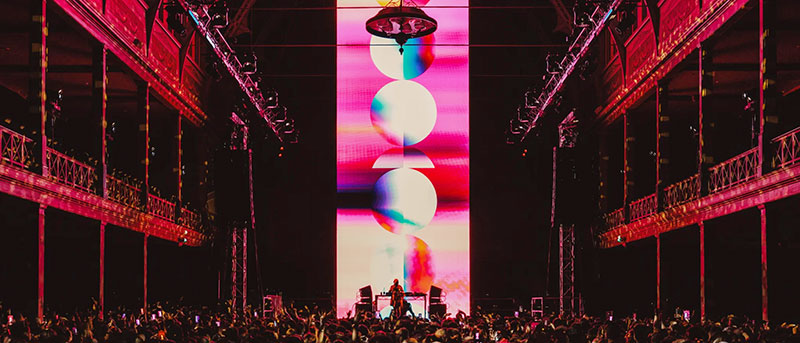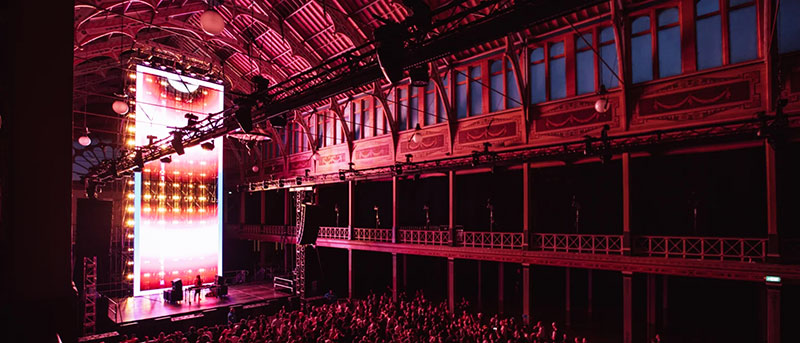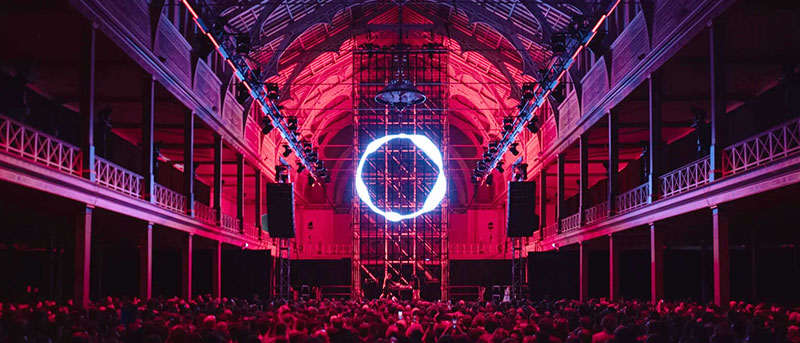Novatech designed an LED/processor configuration to display high-res content created by festival performers, based on transparent ROE LEDs and Brompton Tessera video processors.

The Australian city of Melbourne hosted the inaugural Now or Never festival – a 16-day celebration of digital art and future thinking. The festival used the city as its stage for a wide ranging programme spanning across art, film and music to panel discussions and food held from 17 August to 2 September 2023.
The historic 19th century Royal Exhibition Building became the venue for several events of Now or Never 2023, where performers explored the adventurous and diverse nature of digital creativity. A World Heritage listed site, the building was originally constructed as part of the international exhibition movement of the late 1800s. Technical management company Gig Control was responsible for the design of the lighting, audio and visual elements at the venue.
A Rare Gathering
On one of the festival days, a rare gathering of some of the UK’s most prolific experimental electronic artists converged at the Royal Exhibition Building, resulting in an audio-visual sensory experience for visitors. Included in the line up were Autechre, a pair of electronic musicians from Manchester, and techno producer Max Cooper, who performed against a backdrop of hallucinatory, shifting 3D visuals. Reliable LED processing was vital to ensure the show’s immersive effect.
Gig Control hired production rental company, Novatech Creative Event Technology. to look after the technical supply for five different shows at the venue, taking place on four days of the festival. Events ranged from keynote talks and panel discussions to dance music parties, orchestral performances and 3D shows from electronic artists. To support them, the scope of what Novatech needed to achieve visually was extremely diverse.
“The venue’s age made it a very challenging environment,” said Leko Novakovic, Managing Director at Novatech. “It has a wooden floor and very limited rigging from the wooden ceiling. Because this structure made weight loading an issue, we designed the stage around a central scaffold tower that had LED equipment and lighting suspended from it.”
LED and Processor Control
The screen displayed highly varied, high-resolution customised video content created by the performing artists. Novatech supplied a ROE Visual Vanish V8T high transparency screen, which can be suspended from a hanging bar, with a Brompton 4K Tessera SX40 LED processor and two Tessera XD data distribution units. The set-up stayed in place but was slightly modified each day to suit the varying events.

“The fact that Brompton supports redundant signal control was very reassuring, and the screen configuration allowed us to test it as it was being built,” Leko said. “This meant that any modules that needed replacing could be taken care of at ground level before the whole configuration was raised to its 16-metre position above the stage.”
Apart from processor redundancy that allows users to set-up a backup processor in case the primary unit fails, closed loop redundancy is also available, which works by creating a connection loop from the processor to the panels and back to the processor. This means the panels can receive signals from either end of the connection loop. Should the primary connection of the loop fail or experience a communication error, the processor immediately switches to send the signal through the secondary connection. This typically happens within a single frame, making it imperceptible to viewers.
Brightness and Colour Matching
Brompton’s OSCA (On-Screen Colour Adjustment) user interface, which appears up on the LED wall, gave Novatech controls to quickly make colour matches between different LED panels and modules. They could change luminance and red/green/blue gain controls for all colours, or adjust hue, saturation and luminance independently for the primary and secondary colours and white. It is also possible to correct one colour without affecting others, select a group of modules and incrementally adjust them to match other panels, or iterate until all modules match for a selected colour, leaving an LED wall that appears entirely continuous.
Also, being able to correct the brightness of the seams allowed Leko’s team to achieve a much more polished look. OSCA seam controls automatically detect adjacent LED modules and adjust the brightness of both edges at the same time, compensating visually for bright or dark lines. Because the adjustments are relative instead of absolute, going back and starting from existing seam settings is not necessary.

The Dark Magic feature, one of the Tessera software tools, supported subtle imagery on the screen without colour banding for performances that required lower brightness. LED panels are usually at their best when used at maximum brightness in high ambient lighting conditions. Using them indoors or on-camera at lower brightness can reduce the effective bit depth, causing artefacts. Leko said, “Dark Magic helped with issues such as loss of detail and banding by processing the video signal up to 26 bits per channel.”
On the Dance Floor
As part of Now or Never festival, five DJs transformed the venue into a pulsating dancefloor, bringing together music from all corners of the world. German house producer Âme delivered an unpredictable live techno set, alongside UK electronic producer George Fitzgerald, followed by three Australian DJs – Melbourne’s disco queen CC:DISCO!, DJ Ayebatonye from Sydney and one of Brisbane’s own DJs, dameeeela.
“The visual set-up at the Royal Exhibition Building took the party to a whole new level,” said Leko. “The Brompton processors have the flexibility, reliability and professional features we need at events like Now or Never.” www.bromptontech.com




